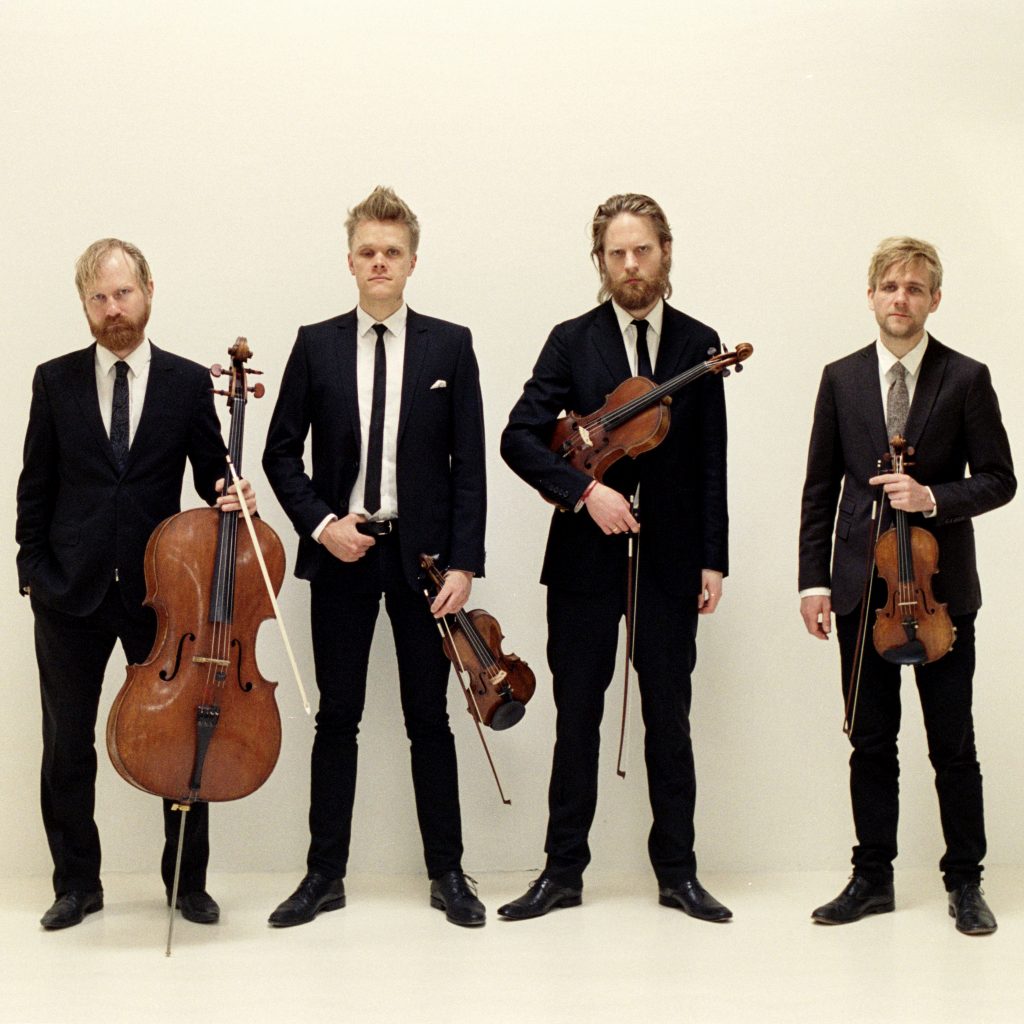The Danish String Quartet Opens Its Musically Probing Prism Project at The Conrad
The Danish String Quartet returned to La Jolla Saturday, November 16, bringing a joyful, sonically resplendent Beethoven String Quartet in E-flat Major, Op. 127, and the smoldering intensity of Dmitri Shostakovich’s String Quartet No. 15 in E-flat Minor, Opus 144. This stirring concert opened their week-long residency under the auspices of the La Jolla Music Society (LJMS) and marked their debut in the organization’s recently opened Baker-Baum Concert Hall at The Conrad.

Danish String Quartet [photo (c.) Caroline Bittencourt]
But I am convinced that the Danish String Quartet stands out among the panoply of contemporary musical colleagues. Every piece I have heard them play comes across with an unusually high level of engagement, an immediacy that is compelling. I observe a uniform level of virtuosity among the players, which is confirmed by the two violinists— Frederik Øland and Rune Tonsgaard Sørenson—regularly exchanging first and second violin chairs. When required, this quartet displays a warm, amazingly unified sonority, yet each player exhibits a clearly identifiable timbre and presonality. The ensemble can be muscular and refined at the same time—or at least nanoseconds apart—and their most robust sound still maintains a laudable transparency.
Before the quartet began their program, violist Ashbjørn Nørgaard explained that the ensemble has named the current series of five programs “The Prism Project” because they see the late quartets of Beethoven influencing later string quartet composers in the same way a prism refracts a ray of light into a spectrum of discrete, different colors. So each program of the series will include a late Beethoven quartet and a later—for the most part 20th-century—composer’s work. And each program will open with a short fugue by J. S. Bach arranged for string quartet.
Although it would be foolish to reduce Beethoven’s Opus 127 String Quartet to a single mood, the Danish String Quartet did use the vibrant opening of its first movement, marked Maestoso, to set their strong interpretive framework of the work. Although the second movement, an expansive Adagio marked molto cantabile, is plotted as a theme and variations, the way Beethoven unfolds and orchestrates this familiar concept is the work’s radical gift—perhaps that specific refraction that points to the Shostakovich Opus 144 the Danes played on their program’s second half.
Beethoven gives his second movement theme to the cello, which Fredrik Schøyen Sjölin gracefully offered in its glistening simplicity, accompanied by whispered chords in the other voices. Throughout the movement’s twists and turns, including a variation that sounded like a folk dance, the Danish String Quartet maintained its heavenly texture—a glowing stillness in which first violinist Frederik Øland’s bright but silvery melodic offerings matched Sjölin’s empyrean standard.
I admired the Danish String Quartet’s robust precision as they tore through the Scherzando vivace and treated the unexpected twists and turns of the Finale with rhapsodic abandon.
Is there another string quartet like Shostakovich’s No. 15 in E-flat Minor with its six continuous slow movements? Eric Bomberger, writer of the astute program notes for the LJMS, finds the composer’s final string quartet dark and bleak, a product of Shostakovich’s disintegrating health as he came close to death. Indeed, he died within a year of the string quartet’s premiere in November of 1974.
Although it would be foolish to describe any lengthy slow work in the key of e-flat minor as cheerful, I hear something else in this string quartet. I hear Shostakovich fearlessly expressing the kinds of musical ideas the Soviet government censors had for so long forbidden or suppressed in his composing when they noted any deviation from the doctrines of Socialist Realism. Listen to all of those short, violent crescendos on single notes that fill the Serenade (the second Adagio), followed by his snarling burlesque of the polite fugue subject from the opening movement. Note also the rogue cadenzas throughout the quartet and the Epilogue’s cello cadenza accompanied by wild pizzicatos from the other instruments. Rather than unrelenting sighs of despair, I hear the final Shostakovich string quartet as a manifesto of stylistic liberation from a composer who knew he had nothing to lose at that stage of his life. And the Danish String Quartet gave us a boldly etched and, yes, beautiful account of the work.
The program opened with Mozart’s string quartet arrangement of J. S. Bach’s E-flat Major Fugue from the second volume of The Well-Tempered Clavier, BWV 876, a short, sunny fugue that was over just as we began to take it seriously. The ensemble’s encore followed their usual pattern: a simply harmonized setting of a Danish folk song.
This concert was presented by the La Jolla Music Society on November 16, 2019, in the Baum-Baker Concert Hall at The Conrad in downtown La Jolla. The organization will present the Danish String Quartet in four additional concerts in this venue: November 17, 22, and 2 concerts on November 23.

Ken Herman, a classically trained pianist and organist, has covered music for the San Diego Union, the Los Angeles Times’ San Diego Edition, and for sandiego.com. He has won numerous awards, including first place for Live Performance and Opera Reviews in the 2017, the 2018, and the 2019 Excellence in Journalism Awards competition held by the San Diego Press Club. A Chicago native, he came to San Diego to pursue a graduate degree and stayed.Read more…

We are so supremely fortunate.